C#核心篇
面向对象的概念
封装(类)、继承,多态
类
类的基本概念
- 具有相同特征、相同行为、一类事物的抽象
- 类是对象的模板,可以通过类创建出对象
- 关键词class
类的申明
申明在nameplace语句块中------也就是要写在class Program 的外面,如果在类(class)里面申明类,那就是内部类
语法
csharp
namespace 面向对象;
#region 类申明语法
// 命名:帕斯卡命名法
// 同一个语句块中的不同类不能重名
//访问修饰符 class 类名{
// //特征------成员变量
// //行为------成员方法(函数)
// //保护特征------成员属性
// //构造函数、析构函数
// //索引器
// //运算符重载
// //静态成员
// }
#endregion
class Program
{
static void Main(string[] args)
{
}
}使用
csharp
namespace 面向对象;
class Person{
}
class Machine{
}
class Program
{
static void Main(string[] args)
{
#region 实例化对象示例(类创建对象)
//类对象都是引用类型的
//语法: 类名 对象名 = new 类名();
//在栈上开辟了一个空间存放地址,但是不开辟 堆内存空间,也就是null
Person p;
Person p1 = null;
//分配堆内存空间
//创建的每个对象只是模板都是同一个类,但是里面的信息都是不同的------------类似造人
Person p2 = new Person();
Person p3 = new Person();
#endregion
}
}习题
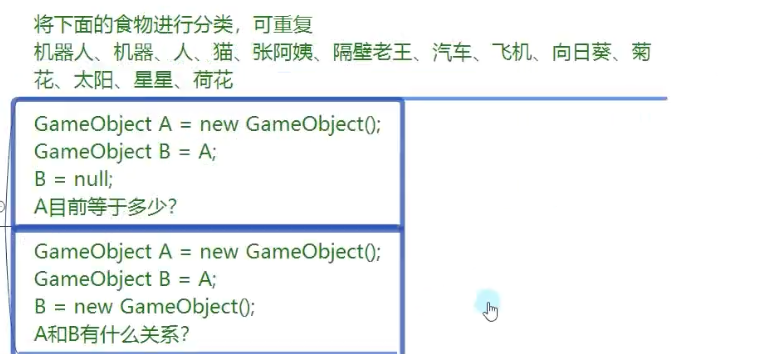
csharp
namespace 类和对象习题;
class Person{
}
class Animal{
}
class Machine{
}
class Plant{
}
class Astro{
}
class Program
{
static void Main(string[] args)
{
// 1
Machine robot = new Machine();
Machine machine = new Machine();
Person people = new Person();
Animal cat = new Animal();
Person aunt = new Person();
Person uncle_Wang = new Person();
Machine car = new Machine();
Machine plane = new Machine();
Plant sunflower = new Plant();
Plant chrysanthemum = new Plant();
Astro sun = new Astro();
Astro star = new Astro();
Plant lotus = new Plant();
}
}A指向一个地址指向一块堆内存
B指向一个地址,地址拷贝自A的地址,所以也指向A的堆内存
B = null :把B的地址与堆内存之间的指向关系断开
所以,A的堆内存没变
A和B没关系成员变量------类的特征
- 申明在类语句块中
- 用来描述对象的特征
- 任意变量类型
- 数量不限
- 赋不赋值都行
csharp
namespace 成员变量;
//性别枚举
enum E_SexType{
Male,
Female,
}
//位置结构体
struct Position{
}
//宠物类
class Pet{
}
class Person{
//特征------成员变量
public string name = "Eano";//可以初始化也可以不初始化
public int age;
public E_SexType sex;
public Position position;
//可以申明任意类的对象,包括自身类
// (这点和结构体就不同,结构体如果申明自身结构体的变量就会无限循环导致报错
// 而在类里申明自身类的对象则没有问题,因为类是引用类型,只是声明一个对该对象的引用,也就是开辟了一个地址空间
// 不能实例化自身类的对象,因为这样的话在后面创建对象的时候就会陷入无限循环)
public Person girlfriend; //不能实例化自身类的对象,初始化为null是可以的
public Person[] friends;
public Pet pet; //可以实例化其他类的对象
}
class Program
{
static void Main(string[] args)
{
//创建对象
Person p = new Person();
#region 成员变量的使用与初始值
//值类型的默认值 都是0
// 相应的bool------false , char------'' ,string------""
//引用类型的默认值 都是null
//调用defalut()方法可以查看默认值
Console.WriteLine(default(int));
Console.WriteLine(default(bool));
Console.WriteLine(default(char));
//如果不申明,那么这个成员变量就是默认值
Console.WriteLine(p.age);
p.age = 25;
Console.WriteLine(p.age);
#endregion
}
}总结:
- 访问修饰符------3P
- 在类里面申明自身类的对象的时候,不能实例化
- defalut()方法得到数据类型的默认值
习题

csharp
3P:
private
public
protected
csharp
namespace 成员变量习题;
class Student{
public string name;
public int age;
public string num;
public Student deskmate;
}
class Classroom{
public string major;
public int capacity;
public Student[] students;
public Classroom(int capacity)
{
this.capacity = capacity;
students = new Student[capacity];
}
}
class Program
{
static void Main(string[] args)
{
//3
Student s1 = new Student();
Student s2 = new Student();
//4
Classroom c1 = new Classroom(5);
}
}
csharp
p.age = 10
csharp
p2.age 是引用类型,拷贝的时候拷贝的是p.age的地址,改变p2.age的值,p.age也会改变
p.age = 20
csharp
age是值类型,只是拷贝了s.age的值,不指向同一地址,所以s.age不变
s.age = 10
csharp
s.deskmate.age = 20成员方法------类的行为
不要加static关键字
csharp
namespace 成员方法;
class Person{
//成员方法
public void Speak(string message){
Console.WriteLine("{0}说{1}",name,message);
}
public bool IsAdult(){
return age>=18;
}
public void AddFriend(Person p){
if(friends==null) friends = new Person[]{p};
else{
Person[] temp = new Person[friends.Length+1];
for(int i=0;i<friends.Length;i++){
temp[i] = friends[i];
}
friends = temp;
friends[friends.Length-1] = p;
}
}
//成员变量
public Person[] friends;
public string name;
public int age;
}
class Program
{
static void Main(string[] args)
{
Person p = new Person();
p.Speak("Hello");
p.name = "Tom";
p.age = 20;
Console.WriteLine(p.IsAdult());
Person p2 = new Person(){name="Jerry",age=25};
p.AddFriend(p2);
Console.WriteLine(string.Join(",",p.friends.Select(f=>f.name)));
}
}习题

csharp
namespace 成员方法习题;
class Student{
public void Speak(string message){
Console.WriteLine("{0} says: {1}",name,message);
}
public void Eat(Food food){
Console.WriteLine("{0} is eating {1},calories: {2}",name,food.name,food.calories);
}
public string name;
}
class Food{
public string name;
public int calories;
}
class Program
{
static void Main(string[] args)
{
Student student = new Student(){name="Alice"};
Food apple = new Food(){name="apple",calories=50};
student.Eat(apple);
}
}构造、析构函数、垃圾回收机制
构造函数------初始化时调用
- 在类里面用于调用时快速初始化的函数
- 没有构造函数的时候默认存在一个无参构造函数
也就是Person p = new Person();
写法:
和结构体一样,构造函数名要和类名相同
csharp
namespace 构造_析构函数;
class Person{
public string name;
public int age;
//构造函数
//类中允许申明无参构造函数,结构体则不允许
public Person(){
name = "eano";
age = 18;
}
//构造函数可以被重载
public Person(string name, int age){
this.name = name;
this.age = age;
}
}
class Program
{
static void Main(string[] args)
{
//现在有了3种申明并初始化对象的方式
Person p = new Person();
Console.WriteLine("Name: " + p.name);
Person p2 = new Person("eano", 18);
Console.WriteLine("Name: " + p2.name);
Person p3 = new Person(){name = "eano", age = 18};
Console.WriteLine("Name: " + p3.name);
}
}注意:
- 有参构造函数 会顶掉 默认的无参构造函数。
- 想要保留无参构造函数,需要重载出来
- this用来区分类内成员变量和外部传入参数
构造函数的特殊写法
:this(可选参数)复用代码
先进入无参构造函数
作用:复用先进入的构造函数代码
csharp
class Person{
public string name;
public int age;
//构造函数
//类中允许申明无参构造函数,结构体则不允许
public Person(){
name = "eano";
age = 18;
}
// //构造函数可以被重载
// public Person(string name, int age){
// this.name = name;
// this.age = age;
// }
//构造函数的特殊写法,在构造函数后:this(可选参数)
public Person(string name, int age) : this(){
Console.WriteLine("先进入无参构造函数");
}
public Person(string name, int age) : this(name){
Console.WriteLine("先进入string类型参数的构造函数");
}
}:this(可选参数)可以指定先进入的构造函数
可选参数可以写死,比如
:this(int类型参数名)就是先进入参数为int类型的构造函数
:this(string类型参数名)就是先进入参数为string类型的构造函数
习题

csharp
namespace 构造_析构函数习题;
class Person{
public string name;
public int age;
//构造函数
public Person(){
name = "eano";
age = 25;
}
//重载
public Person(string name, int age){
this.name = name;
this.age = age;
}
//特殊的构造函数
public Person(string name):this(){
Console.WriteLine("有参构造函数里的name:"+name);
}
}
class Ticket{
uint distance;
float price;
//构造函数
public Ticket(uint distance){
this.distance = distance;
//price是通过GetPrice()方法计算出来的
price = GetPrice();
}
//成员方法
public float GetPrice(){
if(distance > 300){
return distance * 0.8f;
}
else if(distance > 200){
return distance * 0.9f;
}
else if(distance > 100){
return distance * 0.95f;
}
else{
return distance * 1.0f;
}
}
public void PrintPrice(){
Console.WriteLine("距离{0}的票价为:{1}",distance,GetPrice());
}
}
class Program
{
static void Main(string[] args)
{
//1
//先进入无参构造函数,再进入有参构造函数
Person p1 = new Person("John");
Console.WriteLine(p1.name+" "+p1.age);
//3
Ticket t1 = new Ticket(250);
t1.PrintPrice();
}
}析构函数------释放时调用
当引用类型的堆内存真正被回收时,调用析构函数
C++需要手动管理内存,所以才需要在析构函数中做内存回收处理
C#有自带的自动垃圾回收机制,所以不太需要析构函数,除非想在某个对象被垃圾回收时做一些特殊处理
要写在类里面
csharp
~类名(){
}垃圾回收机制GC
原理:遍历堆(Heap)上动态分配的所有对象,通过识别是否被引用来确定哪些对象是垃圾,然后回收释放
垃圾回收的算法:
- 引用计数
- 标记清除
- 标记整理
- 复制集合
堆(Heap)内存由GC垃圾回收,引用类型
栈(Stack)内存由系统自动管理,值类型在栈中分配内存,有自己的申明周期,自动分配和释放
C#中内存回收机制的原理:
分代算法
0代内存 1代内存 2代内存
新分配的对象都被配置在0代内存中,(0代内存满时)触发垃圾回收
在一次内存回收过程开始时,垃圾回收器会认为堆中全是垃圾,进行以下两步:
- 标记对象:从根(静态字段、方法参数)开始检查引用对象,标记后为可达对象,被标记的为不可达对象------不可达对象就是垃圾
- 搬迁对象压缩堆:(挂起执行托管代码线程)释放未标记的对象,搬迁可达对象到一代内存中,修改可达对象的引用地址为连续的地址
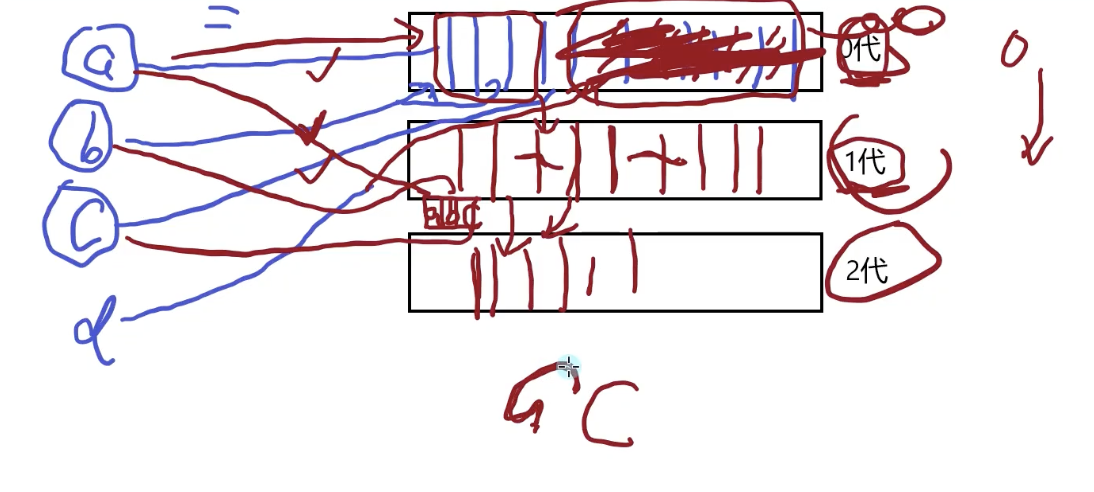
大对象:
大对象是第二代内存,目的是减少性能损耗以提高性能
不会对大对象进行搬迁压缩,85000字节(83kb)以上的对象是大对象
这个机制有点像三级缓存
速度:0 > 1 > 2
容量:0 < 1 < 2
手动进行GC
GC.Collect()
一般在Loading过场动画的时候调用
小节
csharp
class 类名{
//特征------成员变量
//行为------成员的方法
//初始化时调用------构造函数
//释放时调用------析构函数
}成员属性------保护成员变量
- 通过在get和set里面写逻辑,来保护成员变量
- 解决3p的局限性
- 用来让成员变量在外部:只能获取不能修改 / 只能修改不能获取
语法:
csharp
//访问修饰符 属性类型 属性名{
// get{}
// set{}
//}使用:
csharp
namespace 成员属性;
//访问修饰符 属性类型 属性名{
// get{}
// set{}
//}
class Person{
private string name;
private int age;
private int money;
private bool sex;
//成员属性
public string Name{
get{
//返回之前可以写逻辑规则
return name;
}
set{
//设置之前可以写逻辑规则
//value用来接收外部传入的值
name = value;
}
}
public int Money{
get{
//加密处理
return money - 5;
}
set{
//逻辑处理
if(value < 0){
value = 0;
Console.WriteLine("金额不能为负数");
}
//加密处理
//这一部分涉及到加密算法,这里省略
money = value + 5;
}
}
}
class Program
{
static void Main(string[] args)
{
Person p = new Person();
p.Name = "eano";//调用的是set语句块
Console.WriteLine(p.Name);//调用的是get语句块
p.Money = -999;
Console.WriteLine(p.Money);
p.Money = 1000;
Console.WriteLine(p.Money);
}
}get和set前可以加访问修饰符
csharp
#region get和set前可以加访问修饰符
//1. 默认不加,会使用成员属性的访问修饰符(这里就是public)
//2. 加的修饰符要低于成员属性的访问修饰符,否则会报错
//3. 不能让get和set的访问权限都低于成员属性的权限
public int Age{
private get{
return age;
}
set{
age = value;
}
}
#endregionget和set可以只有一个
csharp
#region get和set可以只有一个
//一般只会出现 只有get的情况,只能获取值,不能修改值------------只读属性
//只有一个的时候,不要加修饰符
public bool Sex{
get{
return sex;
}
}
#endregion自动属性
csharp
#region 自动属性
//作用:外部只读不写的特性
//使用场景:一个特征是只希望外部只读不可写,也不加别的特殊处理
public float Height { get; private set; }
//只可以在类内部set
#endregion习题
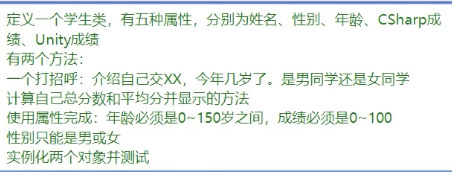
csharp
namespace 成员属性习题;
class Student{
private string name;
private string sex;
private int age;
private int csGrade;
private int unityGrade;
public string Name{get; private set;}
public string Sex{
get{
return sex;
}
private set{
if(value != "男" && value != "女") sex = "unknown";
else sex = value;
}
}
public int Age{
get{
return age;
}
private set{
if(value < 0) age = 0;
else if(value > 150) age = 150;
else age = value;
}
}
public int CsGrade{get; private set;}
public int UnityGrade{
get{
return unityGrade;
}
private set{
if(value < 0) unityGrade = 0;
else if(value > 120) unityGrade = 120;
else unityGrade = value;
}
}
public Student(string name, string sex, int age, int csGrade, int unityGrade){
Name = name;
Sex = sex;
Age = age;
CsGrade = csGrade;
UnityGrade = unityGrade;
}
public void Saymyself(){
Console.WriteLine("My name is {0}, I am {1} years old, a {2}.", Name, Age, Sex);
}
public void SayGrade(){
int sum = CsGrade + UnityGrade;
float average = (float)sum / 2;
Console.WriteLine("My sum grade is {0}, my average grade is {1}.", sum, average);
}
}
class Program
{
static void Main(string[] args)
{
Student student1 = new Student("Tom", "男", 18, 90, 80);
student1.Saymyself();
student1.SayGrade();
Student student2 = new Student("Jerry", "女", 160, 100, 90);
student2.Saymyself();
student2.SayGrade();
}
}索引器------像数组一样访问元素
让对象可以像数组一样通过索引访问元素
注意:结构体中也支持索引器
语法
csharp
class Person{
private string name;
private int age;
private Person[] friends;
#region 索引器语法
//访问修饰符 返回值 this[数据类型 参数名1,数据类型 参数名2,...]{
// 和属性的写法相同:
// get{
// }
// set{
// }
// }
public Person this[int index]{
get{
return friends[index];
}
set{
friends[index] = value;
}
}
#endregion
}用法
csharp
namespace 索引器;
class Person{
private string name;
private int age;
private Person[] friends;
private int[,] array;
public string Name{get;private set;}
public int Age{get;private set;}
public Person[] Friends{get;private set;}
public int[,] Array{get;private set;}
public Person(string name, int age){
Name = name;
Age = age;
friends = new Person[5];
Friends = friends;
array = new int[3, 4];
Array = array;
}
#region 索引器语法
//访问修饰符 返回值 this[数据类型 参数名1,数据类型 参数名2,...]{
// 和属性的写法相同:
// get{
// }
// set{
// }
// }
public Person this[int index]{
get{
#region 索引器里也能写逻辑
if(friends == null || index < 0 || index >= friends.Length){
return null;
}
else{
return friends[index];
}
#endregion
}
set{
if(friends == null){
friends = new Person[]{value};
}
//如果越界,顶掉最后一个元素
else if(index < 0 || index >= friends.Length){
friends[friends.Length - 1] = value;
}
else friends[index] = value;
}
}
#endregion
#region 索引器可以重载
//参数不同
public int this[int row, int col]{
get{
return array[row, col];
}
set{
array[row, col] = value;
}
}
public string this[string str]{
get{
switch(str){
case "name":
return Name;
case "age":
return Age.ToString();
default:
return "Invalid index";
}
}
}
#endregion
}
class Program
{
static void Main(string[] args)
{
Person p1 = new Person("Alice", 25);
p1.Friends[0] = new Person("Bob", 20);
p1[1] = new Person("Charlie", 22);
Console.WriteLine(p1[0].Name);
p1[2, 3] = 10;
Console.WriteLine(p1[2, 3]);
Console.WriteLine("{0}的年龄是{1}, 朋友是{2}", p1["name"],p1["age"],p1[0]["name"]);
}
}索引器就相当于给对象加一个属性,用中括号[参数]调用这个属性的内容
习题

csharp
namespace 索引器习题;
class IntArray{
public int[] arr;
public int length;
public IntArray(int size){
length = 0;
arr = new int[size];
}
//增
public void Add(int index, int value){
if(index < 0 || index > length){
Console.WriteLine("索引超出范围");
return;
}
else{
if(length < arr.Length){
arr[length] = value;
length++;
}
else{
int[] newArr = new int[arr.Length + 1];
for(int i=0;i<arr.Length;i++){
newArr[i] = arr[i];
}
arr = newArr;
//后面元素后移
for(int i = length-1;i>=index;i--){
arr[i+1] = arr[i];
}
arr[index] = value;
length++;
}
}
}
//删
public void Remove(int index){
if(index > length-1 || index < 0){
Console.WriteLine("索引超出范围");
return;
}
else{
//后面元素前移
for(int i = index;i<length-1;i++){
arr[i] = arr[i+1];
}
length--;
}
}
//索引器
//查
//改
public int this[int index]{
get{
return arr[index];
}
set{
arr[index] = value;
}
}
}
class Program
{
static void Main(string[] args)
{
IntArray arr = new IntArray(5);
arr.Add(0,1);
arr.Add(1,2);
arr.Add(2,3);
arr.Add(3,4);
arr.Add(4,5);
arr.Add(5,6);
for(int i=0;i<arr.length;i++){
Console.Write(arr[i] + " ");
}
Console.WriteLine();
Console.WriteLine(arr.length);
arr.Remove(2);
for(int i=0;i<arr.length;i++){
Console.Write(arr[i] + " ");
}
Console.WriteLine();
Console.WriteLine(arr.length);
arr[0] = 10;
Console.WriteLine(arr[0]);
}
}静态成员------类名.出来使用
静态关键字 static
修饰成员变量、方法、属性
静态成员可以用 类名.静态成员名直接调用
一般写成public公共的
申明与使用
csharp
namespace 静态成员;
class Test{
static public float PI = 3.14f;
public int testInt = 10;
static public float CircleArea(float r){
#region 静态函数不能访问非静态成员
// 非静态成员只能在实例化对象后调用
Test t = new Test();
Console.WriteLine(t.testInt);
#endregion
return PI * r * r;
}
public void TestFunc(){
Console.WriteLine("This is a test function");
#region 非静态函数可以使用静态成员
Console.WriteLine(PI);
Console.WriteLine(CircleArea(5));
#endregion
}
}
class Program
{
static void Main(string[] args)
{
#region 静态成员的使用
Console.WriteLine(Test.PI);
// Console.WriteLine(Test.testInt); // 不能直接类名.调用
// 非静态成员只能在实例化对象后调用
Test t = new Test();
Console.WriteLine(t.testInt);
Console.WriteLine(Test.CircleArea(5));
//Console.WriteLine(Test.TestFunc());// 不能直接类名.调用
t.TestFunc();
#endregion
}
}为什么可以类名.静态成员名使用
程序开始运行的时候,就会给静态成员分配内存空间
静态成员与程序共生死
每个静态成员都会有一个唯一的内存空间
直到程序结束,静态成员的内存空间才会被释放
作用
- 申明唯一变量
- 方便在其他地方获取的对象的申明
- 申明唯一方法------相同规则的数学计算
问题
长期占用内存空间,其他非静态成员gc的阈值变小,程序性能降低
常态和静态变量
相同点:
- 都可以通过类名.出来使用
不同点:
- const修饰常量,必须初始化,不能修改
- const要直接写在变量的前面,也就是访问修饰符的后面
- const只能修饰变量,static还可以修饰方法、属性
习题

csharp
namespace 静态成员习题;
//单例模式
class Test{
private static Test t = new Test();
public int testInt = 10;
public static Test T{
get{
return t;
}
}
private Test(){
}
}
class Program
{
static void Main(string[] args)
{
Console.WriteLine(Test.T.testInt);
Test.T.testInt = 20;
// Test t1 = new Test(); //外部无法实例化
Console.WriteLine(Test.T.testInt);
}
}静态类和静态构造函数
作为工具使用,就像Console类一样,直接类名.出来使用静态成员
静态类
static修饰的类
- 只能包含静态成员
- 不能被实例化
作用:
- 将常用的静态成员写在静态类中
- 静态类不能被实例化,体现工具类的唯一性
静态构造函数
static修饰的构造函数
- 静态类和非静态类都可以用静态构造函数
- 静态构造函数不能使用访问修饰符
- 不能有参数
- 只会调用一次
静态构造函数只会在第一次使用类的时候调用一次,与类是否是静态类无关
普通构造函数每次实例化类的对象都会调用一次
csharp
using System.Runtime.CompilerServices;
namespace 静态类和静态构造函数;
#region 静态类
static class TestStatic{
public static void TestFunc(){
}
//静态类只能包含静态成员
// public void Say(){
// }
public static int TestIndex{get;set;}
}
#endregion
#region 静态构造函数
//1. 静态类中的静态构造函数
static class StaticClass{
public static int testInt = 10;
//静态构造函数不能加访问修饰符
//无参
static StaticClass(){
Console.WriteLine("静态类中的静态构造函数执行");
//在静态构造函数里初始化成员变量
testInt = 20;
}
}
//2. 普通类中的静态构造函数
class NormalClass{
public static int testInt = 10;
static NormalClass(){
Console.WriteLine("普通类中的静态构造函数执行");
//在静态构造函数里初始化成员变量
testInt = 20;
}
public NormalClass(){
Console.WriteLine("普通类中的普通构造函数执行");
}
}
#endregion
class Program
{
static void Main(string[] args)
{
//调用两次静态成员,但只执行一次静态构造函数
Console.WriteLine(StaticClass.testInt);
Console.WriteLine(StaticClass.testInt);
//普通类中的静态构造函数也只执行一次
Console.WriteLine(NormalClass.testInt);
Console.WriteLine(NormalClass.testInt);
//普通类中的普通构造函数每次实例化都会执行
NormalClass nc = new NormalClass();
NormalClass nc2 = new NormalClass();
}
}习题

csharp
namespace 静态类和静态构造函数习题;
static class MathCalc{
const float pi = 3.14f;
public static float CircleArea(float r){
Console.WriteLine("半径为{0}的圆的面积为{1}", r, pi * r * r);
return pi * r * r;
}
public static float CirclePerimeter(float r){
Console.WriteLine("半径为{0}的圆的周长为{1}", r, 2 * pi * r);
return 2 * pi * r;
}
public static float RectangleArea(float a, float b){
Console.WriteLine("长为{0}宽为{1}的矩形的面积为{2}", a, b, a * b);
return a * b;
}
public static float RectanglePerimeter(float a, float b){
Console.WriteLine("长为{0}宽为{1}的矩形的周长为{2}", a, b, 2 * (a + b));
return 2 * (a + b);
}
public static float Abs(float n){
float n1 = (n > 0)?n:-n;
Console.WriteLine("{0}绝对值为{1}", n, n1);
return n1;
}
static MathCalc(){
Console.WriteLine("静态构造函数执行");
}
}
class Program
{
static void Main(string[] args)
{
MathCalc.CircleArea(5);
MathCalc.CirclePerimeter(5);
MathCalc.RectangleArea(5, 10);
MathCalc.RectanglePerimeter(5, 10);
MathCalc.Abs(-5);
}
}拓展方法
为现有非静态变量类型 添加新方法
作用:
- 提升程序拓展性
- 不需要在对象中重新写方法
- 不需要继承来添加方法
- 为别人封装的类写额外的方法
特点:
- 一定写在静态类中
- 一定是一个静态函数
- 第一个参数是拓展目标(想要拓展方法的类型),要用this修饰
语法
csharp
访问修饰符 static 返回值类型 函数名(this 拓展类名 参数名,参数数据类型 参数, ...){
}
csharp
namespace 拓展方法;
#region 语法
//访问修饰符 static 返回值类型 函数名(this 拓展类名 参数名,参数数据类型 参数, ...){
//
//}
#endregion
#region 示例
static class Tools{
public static void Print(this string str){
Console.WriteLine("为string拓展方法:"+str);
}
}
#endregion
class Program
{
static void Main(string[] args)
{
string str = "Hello World";
str.Print(); //调用拓展方法
}
}使用
csharp
namespace 拓展方法;
#region 语法
//访问修饰符 static 返回值类型 函数名(this 拓展类名 参数名,参数数据类型 参数, ...){
//
//}
#endregion
#region 示例
static class Tools{
public static void Print(this string str){
Console.WriteLine("为string拓展方法:"+str);
}
public static void PrintInfo(this string str, string str1, int num){
Console.WriteLine("拓展方法的对象:"+str);
Console.WriteLine("传入的参数:"+str1 + " " + num);
}
public static void PrintInfo(this Test t){
Console.WriteLine("为Test类拓展方法:"+t.i);
}
//如果拓展的方法名和类里面的方法重名,优先使用类的方法
public static void Func(this Test t){
Console.WriteLine("为Test类拓展同名方法:");
}
}
#endregion
#region 为自定义的类型拓展方法
class Test{
public int i = 10;
public void Func(){
Console.WriteLine("Test类自己的Func方法");
}
}
#endregion
class Program
{
static void Main(string[] args)
{
string str = "Hello World";
str.Print(); //调用拓展方法
str.PrintInfo("你好", 123); //调用拓展方法
//为自定义的类型拓展方法
Test t = new Test();
t.PrintInfo(); //调用拓展方法
t.Func(); //重名,优先调用类自己的方法
}
}注意:
如果拓展的方法名和类里面的方法重名,优先使用类的方法
习题

csharp
namespace 拓展方法习题;
//1
//平方
static class Test{
public static int Square(this int n){
Console.WriteLine("Square of " + n + " is " + (n*n));
return n*n;
}
public static void Suicide(this Player player){
Console.WriteLine("Player " + player.name + " is suiciding!");
}
}
//2
//玩家
class Player{
public string name;
public int hp;
public int atk;
public int def;
public Player(string name, int hp, int atk, int def){
this.name = name;
this.hp = hp;
this.atk = atk;
this.def = def;
}
public void Attack(Player target){
Console.WriteLine(this.name + " attacks " + target.name + "!");
target.hp -= this.atk - target.def;
Console.WriteLine(target.name + " now has " + target.hp + " HP.");
if(this.atk - target.def > 0){
Hurted(target);
}
}
public void Move(int x, int y){
Console.WriteLine(this.name + " moves to (" + x + ", " + y + ").");
}
public void Hurted(Player target){
Console.WriteLine(target.name + " is hurt!");
}
}
class Program
{
static void Main(string[] args)
{
//1
int num = 3;
num.Square();
//2
Player player1 = new Player("player1", 100, 10, 5);
Player player2 = new Player("player2", 100, 13, 2);
player1.Attack(player2);
player1.Move(1, 2);
player1.Suicide();
player2.Attack(player1);
player2.Suicide();
}
}运算符重载------自定义对象能够运算
让自定义的类和结构体对象 能够使用运算符
关键字: operator
特点:
- 必须是公共的静态方法
- 返回值写在operator前
注意:
- 条件运算符需要成对实现
- 一个符号可以多个重载
- 不能使用ref和out
语法
csharp
//语法
//public static 类名 返回类型 operator 运算符(参数类型1 参数名1, 参数类型2 参数名2){
//}用法实例
csharp
namespace 运算符重载;
class Program
{
//语法
//public static 类名 返回类型 operator 运算符(参数类型1 参数名1, 参数类型2 参数名2){
//}
//实例
class Point {
public int x, y;
public static Point operator +(Point p1, Point p2) {
Point p = new Point();
p.x = p1.x + p2.x;
p.y = p1.y + p2.y;
return p;
}
//重载
public static Point operator +(Point p1, int num) {
Point p = new Point();
p.x = p1.x + num;
p.y = p1.y + num;
return p;
}
}
static void Main(string[] args)
{
Point p1 = new Point();
p1.x = 1;
p1.y = 2;
Point p2 = new Point();
p2.x = 3;
p2.y = 4;
Point p3 = p1 + p2;
Console.WriteLine("p3.x = " + p3.x);
Point p4 = p1 + 2;
Console.WriteLine("p4.x = " + p4.x);
//可以连续使用
p4 = p1 + p2 + 3;
Console.WriteLine("p4.x = " + p4.x);
}
}可重载和不可重载的运算符
csharp
#region 可重载的运算符
//算数运算符:+ - * / % ++ --
// (自增自减的参数只有一个)
//逻辑运算符:!
// ( &&和||不能重载 )
//位运算符:~ & | ^ << >>
// (~只有一个参数)
// (左移右移的参数Point p,int num)
//条件运算符:> < >= <= == !=
//条件运算符需要成对实现
// 也就是>和<需要成对重载,>=和<=需要成对重载,==和!=需要成对重载
#endregion
#region 不可重载的运算符
//逻辑运算符:&& ||
//索引符:[]
//强转运算符:()
//特殊运算符:点. 三目运算符的? 赋值符号=
#endregion习题

csharp
namespace 运算符重载习题;
//1
class Position{
public int x;
public int y;
public static bool operator ==(Position p1, Position p2){
if(p1.x == p2.x && p1.y == p2.y){
return true;
}
return false;
}
public static bool operator !=(Position p1, Position p2){
if(p1.x!= p2.x || p1.y!= p2.y){
return true;
}
return false;
}
}
//2
class Vector3{
public int x;
public int y;
public int z;
public static Vector3 operator +(Vector3 v1, Vector3 v2){
Vector3 result = new Vector3();
result.x = v1.x + v2.x;
result.y = v1.y + v2.y;
result.z = v1.z + v2.z;
return result;
}
public static Vector3 operator -(Vector3 v1, Vector3 v2){
Vector3 result = new Vector3();
result.x = v1.x - v2.x;
result.y = v1.y - v2.y;
result.z = v1.z - v2.z;
return result;
}
public static Vector3 operator *(Vector3 v1, int n){
Vector3 result = new Vector3();
result.x = v1.x * n;
result.y = v1.y * n;
result.z = v1.z * n;
return result;
}
}
class Program
{
static void Main(string[] args)
{
//1
Position a = new Position();
a.x = 1;
a.y = 2;
Position b = new Position();
b.x = 1;
b.y = 2;
Console.WriteLine(a == b); // True
Console.WriteLine(a!= b); // False
//2
Vector3 v1 = new Vector3();
v1.x = 1;
v1.y = 2;
v1.z = 3;
Vector3 v2 = new Vector3();
v2.x = 2;
v2.y = 3;
v2.z = 4;
Vector3 v3 = v1 + v2;
Console.WriteLine("(v3.x, v3.y, v3.z) = ({0}, {1}, {2})", v3.x, v3.y, v3.z);
Vector3 v4 = v1 - v2;
Console.WriteLine("(v4.x, v4.y, v4.z) = ({0}, {1}, {2})", v4.x, v4.y, v4.z);
Vector3 v5 = v1 * 2;
Console.WriteLine("(v5.x, v5.y, v5.z) = ({0}, {1}, {2})", v5.x, v5.y, v5.z);
}
}内部类和分部类
内部类------在一个类中申明一个类
要用包裹者点出这个内部类
作用:亲密关系的体现,有点像继承
注意:访问修饰符作用很大
csharp
namespace 内部类和分部类;
#region 内部类
class Person{
public string name;
public int age;
public Body body;
public class Body{
Arm leftArm;
Arm rightArm;
class Arm{
}
}
}
#endregion
class Program
{
static void Main(string[] args)
{
Person person = new Person();
person.body = new Person.Body();
//访问修饰符的作用,不写public,则无法访问
// person.body.leftArm = new Person.Body.Arm();
}
}分部类------一个类分成几部分申明
关键字:partial
作用:分部描述一个类,增加程序的可拓展性
注意:
- 分部类可以写在多个脚本文件中
- 分部类的访问修饰符要一致
- 分部类中不能有重复的成员
csharp
namespace 内部类和分部类;
#region 内部类
class Person{
public string name;
public int age;
public Body body;
public class Body{
Arm leftArm;
Arm rightArm;
class Arm{
}
}
}
#endregion
#region 分部类
partial class Student{
public bool sex;
public string name;
}
partial class Student{
public int age;
//注意不要重复成员名
// public string name;
public void SayHello(){
Console.WriteLine("Hello,I'm {0},age is {1}",name,age);
}
}
#endregion
class Program
{
static void Main(string[] args)
{
//内部类
Person person = new Person();
person.body = new Person.Body();
//访问修饰符的作用,不写public,则无法访问
// person.body.leftArm = new Person.Body.Arm();
//分部类
Student student = new Student();
student.age = 18;
student.name = "Tom";
student.sex = true;
student.SayHello();
}
}分部方法------将方法的申明和实现分离
注意:
- 不能加访问修饰符,默认私有
- 只能在分部类里申明
- 返回值只能是void
- 参数不能用out关键字
csharp
namespace 内部类和分部类;
#region 内部类
class Person{
public string name;
public int age;
public Body body;
public class Body{
Arm leftArm;
Arm rightArm;
class Arm{
}
}
}
#endregion
#region 分部类
partial class Student{
public bool sex;
public string name;
public partial void SayHello();
}
partial class Student{
public int age;
//注意不要重复成员名
// public string name;
public partial void SayHello(){
Console.WriteLine("I'm {0},age:{1}", name, age);
}
}
#endregion
class Program
{
static void Main(string[] args)
{
//内部类
Person person = new Person();
person.body = new Person.Body();
//访问修饰符的作用,不写public,则无法访问
// person.body.leftArm = new Person.Body.Arm();
//分部类
Student student = new Student();
student.age = 18;
student.name = "Tom";
student.sex = true;
student.SayHello();
}
}继承
继承的基本概念
子类继承父类的所有成员、特征和行为
子类可以有自己的特征和行为
单根性:子类只能有一个父类
传递性 :子类可以间接继承父类的父类
语法
csharp
namespace 继承;
#region 继承语法
class Teacher{
public string name;
public int number;
public void PrintName(){
Console.WriteLine("My name is " + name + " " + number);
}
}
//子类
class TeachingTeacher : Teacher{
//子类独有的属性
public string subject;
public void PrintSubject(){
Console.WriteLine("My subject is " + subject);
}
}
//子类的子类
class ChineseTeacher : TeachingTeacher{
public void PrintChinese(){
Console.WriteLine("xxxx");
}
}
#endregion
class Program
{
static void Main(string[] args)
{
TeachingTeacher teacher1 = new TeachingTeacher();
teacher1.name = "John";
teacher1.number = 9527;
teacher1.subject = "Math";
teacher1.PrintName();
teacher1.PrintSubject();
//传递性继承
ChineseTeacher teacher2 = new ChineseTeacher();
teacher2.name = "Mary";
teacher2.number = 9528;
teacher2.subject = "Chinese";
teacher2.PrintName();
teacher2.PrintSubject();
teacher2.PrintChinese();
}
}访问修饰符对继承的影响
private、public、protected、internal
private:只有内部能访问,子类不能访问,但是子类里可以调用父类的公共方法来间接传入private参数(实际上还是在父类里面调用的private参数)
csharp
class Teacher{
public string name;
private int number;
public void PrintName(int number){
this.number = number;
Console.WriteLine("My name is " + name + " " + number);
}
}
//子类
class TeachingTeacher : Teacher{
public new string name;
//子类独有的属性
public string subject;
public void PrintSubject(int number){
//子类里可以调用父类的公共方法来间接传入private参数
PrintName(number);
Console.WriteLine("My subject is " + subject);
}
}protected:保护的是内部和子类
也就是希望外部不能调用,但是其内部和子类可以调用
csharp
namespace 继承;
#region 继承语法
class Teacher{
public string name;
protected int number;
public void PrintName(int number){
//内部可以调用protected属性
this.number = number;
Console.WriteLine("My name is " + name + " " + number);
}
}
//子类
class TeachingTeacher : Teacher{
//子类独有的属性
public string subject;
public void PrintSubject(int number){
//子类里可以调用protected属性
this.number = number;
Console.WriteLine("My subject is " + subject);
}
}
//子类的子类
class ChineseTeacher : TeachingTeacher{
public void PrintChinese(int number){
this.number = number;
Console.WriteLine("xxxx");
}
}
#endregion
class Program
{
static void Main(string[] args)
{
//语法
TeachingTeacher teacher1 = new TeachingTeacher();
teacher1.name = "John";
//外部无法调用protected属性number
// teacher1.number = 9527;
teacher1.subject = "Math";
//只能公共方法来传参,因为内部和子类可以访问protected属性
teacher1.PrintName(9527);
teacher1.PrintSubject(9527);
//传递性继承
ChineseTeacher teacher2 = new ChineseTeacher();
teacher2.name = "Mary";
//外部无法调用protected属性number
// teacher2.number = 9528;
teacher2.subject = "Chinese";
//只能公共方法来传参,因为内部和子类可以访问protected属性
teacher2.PrintName(9528);
teacher2.PrintSubject(9528);
teacher2.PrintChinese(9528);
}
}internal:内部的,只有在同一个程序集文件中,内部类型或成员才能访问
在后面命名空间再讲internal
子类和父类的同名成员
C#中允许出现子类和父类存在同名成员:
子类里可以命名和父类同名的成员,但是声明子类对象的时候,子类的成员会顶替父类。
最好别用这个特性
要用的时候,最好在前面加上new,用来表明这是一个新的成员,顶替父类里的同名成员。

习题

csharp
namespace 继承习题;
class Person{
public string name;
public int age;
public void SayHello(){
Console.WriteLine("Hello, my name is " + name + " and I am " + age + " years old.");
}
}
class Warrior : Person{
public void Atk(Person person){
Console.WriteLine("Warrior {0} attacks {1}!", name, person.name);
}
}
class Program
{
static void Main(string[] args)
{
Person person = new Person();
person.name = "Alice";
Warrior warrior = new Warrior();
warrior.name = "John";
warrior.age = 30;
warrior.SayHello();
warrior.Atk(person);
}
}继承_里氏替换原则
面向对象七大原则
开闭原则:对扩展开放,对修改封闭
单一职责原则:一个类只负责一项职责
依赖倒置原则:高层模块不应该依赖低层模块,二者都应该依赖抽象
接口隔离原则:使用多个专门的接口,而不使用单一的总接口
迪米特法则:一个对象应该对其他对象有最少的了解
里氏替换原则:子类对象必须能够替换其父类对象
违反开闭原则:违反开闭原则的设计是不好的设计
里氏替换原则的基本概念
任何父类出现的地方,子类都可以替代
父类容器装子类对象,因为子类对象包含了父类的所有内容
作用:方便进行对象储存和管理
语法
csharp
namespace 继承_里氏替换原则;
class GameObject{
}
class Player : GameObject{
public void Attack(GameObject target){
Console.WriteLine("{0}Attack{1}", this, target);
}
}
class Monster : GameObject{
}
class Boss : GameObject{
}
class Program
{
static void Main(string[] args)
{
#region 里氏替换原则语法
//父类容器 装 子类对象
GameObject player = new Player();
GameObject monster = new Monster();
GameObject boss = new Boss();
GameObject[] objects = new GameObject[] { new Player(), new Monster(), new Boss()};
#endregion
}
}这样写了之后不能子类名.调用其方法,所以有了下面的两个关键字。
is 和 as 关键字
is判断,as转换
is:判断一个对象是否是指定类对象
返回:bool
语法很接近自然语言
csharp
#region is 和 as 关键字
if(player is Player){
}
else if(player is Monster){
}
#endregionas:讲一个对象转换为指定类对象
返回:指定类型对象,否则失败就返回null
csharp
Player p = player as Player;
Monster m = player as Monster;
Console.WriteLine(p);
Console.WriteLine(m == null);//trueis和as配合使用
csharp
#region is和as的配合使用
if(player is Player){
// Player p1 = player as Player;
// p1.Attack(monster);
(player as Player).Attack(monster);
}
#endregion
csharp
//当不知道objects数组里的内容,需要遍历判断
for(int i = 0; i < objects.Length; i++){
//objects数组里的Player类型对象
if(objects[i] is Player){
(objects[i] as Player).Attack(monster);
}
else if(objects[i] is Monster){
//objects数组里的Monster类型对象
//...
}
else if(objects[i] is Boss){
//objects数组里的Boss类型对象
//...
}
}不能用子类容器装父类对象
因为父类对象的方法比子类少
csharp
// Player p2 = new GameObjects(); //错误习题

csharp
namespace 继承_里氏替换原则习题;
class Monster{
}
class Boss : Monster{
public void Skill(){
Console.WriteLine("Boss Skill");
}
}
class Goblin : Monster{
public void Atk(){
Console.WriteLine("Goblin Atk");
}
}
class Player{
public Weapon nowWeapon;
public Player(){
//默认武器:匕首
nowWeapon = new Dagger();
}
//切换武器
public void Converse(Weapon weapon){
nowWeapon = weapon;
}
public void PrintWeapon(){
Console.WriteLine("now I have a {0}", nowWeapon.name);
}
}
class Weapon{
public string name;
}
class MP9 : Weapon{
public MP9(){
name = "MP9";
}
}
class ShotGun : Weapon{
public ShotGun(){
name = "ShotGun";
}
}
class Pistol : Weapon{
public Pistol(){
name = "Pistol";
}
}
class Dagger : Weapon{
public Dagger(){
name = "Dagger";
}
}
class Program
{
static void Main(string[] args)
{
//习题1
Random r = new Random();
int randomNum;
Monster[] monsters = new Monster[10];
//随机生成10个怪物,二者生成概率都是50%
for(int i = 0; i < monsters.Length; i++){
randomNum = r.Next(0,2);
if(randomNum == 1){
monsters[i] = new Boss();
}
else{
monsters[i] = new Goblin();
}
}
for(int i = 0; i < monsters.Length; i++){
if(monsters[i] is Boss){
(monsters[i] as Boss).Skill();
}
else if(monsters[i] is Goblin){
(monsters[i] as Goblin).Atk();
}
}
//习题2
Player player = new Player();
player.PrintWeapon();
Console.WriteLine("下面开始捡东西");
Weapon[] weapons = new Weapon[4]{new MP9(), new ShotGun(), new Pistol(), new Dagger()};
for(int i = 0; i < weapons.Length; i++){
player.Converse(weapons[i]);
player.PrintWeapon();
}
}
}继承中的构造函数
当申明一个子类对象的时候,先执行父类的构造函数,再执行子类的构造函数
注意:
- 父类的无参构造
子类默认调用的是父类的无参构造函数
csharp
#region 父类无参构造函数的重要性
class Parent{
//有参构造函数会顶掉无参构造函数
public Parent(int i){
Console.WriteLine("Parent 构造函数");
}
}
class Child: Parent{
//子类默认调用的是父类的无参构造函数
//找不到父类无参构造函数,会报错
public Child(){
Console.WriteLine("Child 构造函数");
}
}
#endregion- 子类可以通过base关键字,调用父类的指定构造函数
(先调用父类,再调用子类另外写的)
csharp
#region 通过base关键字,调用父类的指定构造函数
class Parent{
//有参构造函数会顶掉无参构造函数
public Parent(int i){
Console.WriteLine("Parent 有参int构造函数");
}
public Parent(string str){
Console.WriteLine("Parent 有参string构造函数");
}
}
class Child: Parent{
//base(传入父类构造函数的参数)
public Child(int i) : base(i){
Console.WriteLine("Child int参数构造函数");
}
public Child(string str) : base(str){
Console.WriteLine("Child str参数构造函数");
}
//调用父类的有参int构造函数
public Child(int i, string str) : base(i){
Console.WriteLine("Child 两个参数构造函数");
}
//通过调用该子类的第一个构造函数(int i),
// 间接调用父类的有参int构造函数
// public Child(int i, string str):this(i){
// }
// 和上面是等价的
}
#endregion习题

csharp
namespace 继承_构造函数习题;
class Worker{
public string jobType;
public string jobContent;
public Worker(){
}
public Worker(string jobType, string jobContent){
this.jobType = jobType;
this.jobContent = jobContent;
}
public void Work(){
Console.WriteLine("I am a worker, my job is {0} and my job content is {1}", jobType, jobContent);
}
}
class Programmer : Worker{
public Programmer():base("Programmer", "Coding"){
}
}
class Strategist : Worker{
public Strategist():base("Strategist", "Planning"){
}
}
class Artist : Worker{
public Artist():base("Artist", "Drawing"){
}
}
class Program
{
static void Main(string[] args)
{
Programmer p = new Programmer();
p.Work();
Strategist s = new Strategist();
s.Work();
Artist a = new Artist();
a.Work();
}
}万物之父和装箱拆箱
万物之父
关键字:object
object是所有类型的基类
作用:
- 利用里氏替换原则,用object作为父类容器装所有对象
- 用来表示不确定类型,作为函数的参数类型
csharp
namespace 继承_万物之父与装箱拆箱;
class Father{
public void Speak(){
Console.WriteLine("I am Father.");
}
}
class Son : Father{
}
class Program
{
static void Main(string[] args)
{
//用object容器装任意对象
object o = new Son();
Son s = new Son();
o = s;
Father f = new Father();
o = f;
//用is和as来调用容器里的对象的成员
if(o is Father)(o as Father).Speak();
#region object对象的类型转换
//值类型 ------ 强转
//用object容器装任意值类型
object o2 = 1f;
//要当成数字用的话,需要强转
int f1 = (int)o2;
//引用类型 ------ as转换
//string类型
object o3 = "111";
string s1 = (string)o3;
s1 = o3 as string;
s1 = o3.ToString();
//数组类型
object o4 = new int[3];
int[] arr = o4 as int[];
arr = (int[])o4;
#endregion
}
}装箱拆箱
装箱:用object存值类型------引用类型存值类型,栈内存会迁移到堆内存
拆箱:把object转为值类型------值类型从引用类型取出,堆内存迁移到栈内存
优点:方便在不确定类型时对参数进行存储和传递
缺点:存在内存迁移,增加性能消耗
csharp
#region 装箱拆箱
object o5 = 3;
int i1 = (int)o5;
Func(1,2,3.1f,"dsadsajda",new Son());
//传任意类型参
void Func(params object[] arr){
}
void Func1(object o){
}
#endregion密封类
关键字sealed修饰的类
让类无法再被继承
类似结扎
csharp
class Father{
}
//表示这就是最后一个子类,不能再往下继承了
//类似结扎
sealed class Son : Father{
}作用:
在面向对象程序设计中,密封类就是不允许某个最底层子类再被继承
可以保证程序的规范性和安全性
继承部分综合习题

csharp
namespace 继承_综合习题;
class Car{
public int speed;
public int maxSpeed;
//当前的人数
public int num;
public Person[] persons;
public Car(int speed, int maxSpeed, int maxNum){
this.speed = speed;
this.maxSpeed = maxSpeed;
this.num = 0;
persons = new Person[maxNum];
}
public void AddPerson(Person person){
if(num >= persons.Length){
Console.WriteLine("车子已满");
return;
}
persons[num] = person;
num++;
}
public void RemovePerson(Person delPerson){
if(delPerson is Driver){
Console.WriteLine("驾驶员不能下车");
return;
}
//只有乘客下车
else{
for(int i = 0; i < persons.Length; i++){
//结束循环的条件是找到空位
if(persons[i] == null){
break;
}
// 找到要删除的对象
else if(persons[i] == delPerson){
// 找到了要删除的对象,将其后面的元素前移一位
for(int j = 0; j < num - 1; j++){
persons[j] = persons[j+1];
}
//最后一个位置清空
persons[num-1] = null;
num--;
break;
}
}
}
}
public void Move(){
}
public void Accident(){
if(speed > maxSpeed)
Console.WriteLine("发生事故");
else
Console.WriteLine("正常");
}
public void PrintNum(){
Console.WriteLine("当前车子乘客数量:" + num);
}
}
class Person{
}
class Driver:Person{
}
class Passenger:Person{
}
class Program
{
static void Main(string[] args)
{
Person d1 = new Driver();
Person p1 = new Passenger();
Person p2 = new Passenger();
Car car = new Car(60, 80, 5);
car.AddPerson(d1);
car.AddPerson(p1);
car.AddPerson(p2);
car.PrintNum();
car.RemovePerson(d1);
car.PrintNum();
car.RemovePerson(p1);
car.PrintNum();
car.Accident();
car.speed = 100;
car.Accident();
}
}多态
多态的基本概念
让继承同一父类的子类们,在执行相同方法的时候有不同的表现
解决问题:让同一个对象有唯一行为的特征
csharp
class Father
{
public void SpeakName()
{
Console.WriteLine("Father类");
}
}
class Son : Father
{
public new void SpeakName()
{
Console.WriteLine("Son类");
}
}
class Program
{
static void Main(string[] args)
{
//如果用里氏替换原则
Father s = new Son();
s.SpeakName(); //这里会打印父类的方法
//只有用as转换成子类对象才会调用子类的方法
(s as Son).SpeakName();
}
}这样写很容易造成混乱,于是就有了多态
多态的实现
前面学过函数重载,这是编译时候的多态,也叫做静态的多态,意思是在程序编译阶段,编译器根据参数的类型和数量来决定调用哪个具体的重载函数版本。
下面介绍的是运行时的多态(vob、抽象函数、接口)
vob
v:virtual(虚函数)
o:override(重写)
b:base(父类)
父类的虚函数,在子类用override重写该函数,可以选择用/不用base。
用里氏替换或者其他方法声明对象,new什么就调用什么的方法ß
csharp
namespace 多态_vob;
class GameObject
{
public string name;
public GameObject(string name)
{
this.name = name;
}
public virtual void Atk()
{
Console.WriteLine("GameObject对象的攻击");
}
}
class Player : GameObject
{
//子类默认找的是父类的无参构造函数,但是上面父类中已经有参构造,顶掉了无参构造
//所以需要:base()继承构造函数
public Player(string name) : base(name)
{
}
//虚函数可以被子类重写
public override void Atk()
{
//base.Atk(); //保留父类的虚函数行为,可以写在这个override方法的任何需要的地方
Console.WriteLine("Player对象的攻击");
}
}
class Program
{
static void Main(string[] args)
{
GameObject p1 = new Player("sb");
p1.Atk();
//这就和原来用as的方式结果一样,但是可读性更强
// (p1 as Player).Atk();
}
}什么时候需要base?
需要保留父类行为就base.方法名()
习题
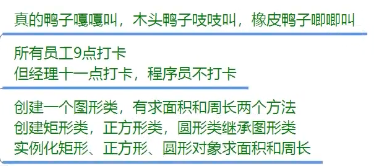
csharp
using System.Drawing;
namespace 多态_vob习题;
//1
class Duck
{
public virtual void Speak()
{
Console.WriteLine("嘎嘎叫");
}
}
class woodenDuck : Duck
{
public override void Speak()
{
Console.WriteLine("吱吱叫");
}
}
class rubberDuck : Duck
{
public override void Speak()
{
Console.WriteLine("唧唧叫");
}
}
//3
class Graph
{
public virtual float area()
{
return 0;
}
public virtual float perimeter()
{
return 0;
}
}
class Rectangle : Graph
{
public float width, length;
public Rectangle(float width, float length)
{
this.width = width;
this.length = length;
}
public override float area()
{
return width * length;
}
public override float perimeter()
{
return 2 * (width + length);
}
}
class Square : Graph
{
public float sideLength;
public Square(float sideLength)
{
this.sideLength = sideLength;
}
public override float area()
{
return sideLength * sideLength;
}
public override float perimeter()
{
return sideLength * 4;
}
}
class Sphere : Graph
{
public float radius;
public Sphere(float radius)
{
this.radius = radius;
}
public override float area()
{
return radius * 3.14f * 3.14f;
}
public override float perimeter()
{
return radius * 2 * 3.14f;
}
}
class Program
{
static void Main(string[] args)
{
//1
Duck d1 = new Duck();
d1.Speak();
Duck w1 = new woodenDuck();
w1.Speak();
Duck r1 = new rubberDuck();
r1.Speak();
//3
Graph rect1 = new Rectangle(1, 2);
Console.WriteLine(rect1.area());
Console.WriteLine(rect1.perimeter());
Graph square1 = new Square(1);
Console.WriteLine(square1.area());
Console.WriteLine(square1.perimeter());
Graph sphere1 = new Sphere(1);
Console.WriteLine(sphere1.area());
Console.WriteLine(sphere1.perimeter());
}
}抽象类和抽象函数
抽象类
关键字:abstract
特点:
- 不能被实例化,但是可以用里氏替换原则作为容器存储对象
- 可以包含抽象方法
- 继承抽象类必须重写他的抽象方法
csharp
namespace 多态_抽象类和抽象函数;
abstract class Thing
{
public string name;
//抽象函数
}
class Water : Thing
{
}
class Program
{
static void Main(string[] args)
{
//抽象类不能被实例化
// Thing t = new Thing(); // 错误
//抽象类的子类可以用里氏替换原则用父类装子类
Thing t = new Water();
//抽象类的子类可以被实例化
Water w = new Water();
}
}抽象函数
又名:纯虚方法
关键字:abstarct
特点:
- 只能在抽象类中申明
- 没有函数体,就是不要写花括号{}
- 不能是私有的
- 继承后必须用override重写
csharp
abstract class Thing
{
public string name;
//抽象函数
public abstract void Show();
//虚函数
public virtual void Test()
{
}
}
class Water : Thing
{
//继承一个有抽象函数的抽象类,必须要实现抽象函数
public override void Show()
{
}
//虚函数可以选择是否要覆盖
public override void Test()
{
}
}抽象函数和虚函数的区别
抽象函数:父类里面一定不能有函数体,只能在抽象类里申明,必须要在其子类里实现,但在子类的子类就可以不用实现了
虚函数:可以选择在父类中写不写函数体,可以在任意类申明,可以选择在子类是否重写
抽象函数和虚函数的共同点
都可以在子类/子类的子类无限重写
习题
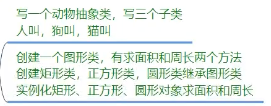
csharp
namespace 多态_抽象类和抽象函数习题;
//1.
abstract class Animal
{
public abstract void Speak();
}
class Person : Animal
{
public override void Speak()
{
Console.WriteLine("人叫");
}
}
class Dog : Animal
{
public override void Speak()
{
Console.WriteLine("狗叫");
}
}
class Cat : Animal
{
public override void Speak()
{
Console.WriteLine("猫叫");
}
}
//2.
abstract class Graph
{
public abstract float area();
public abstract float perimeter();
}
class Rectangle : Graph
{
public float width, length;
public Rectangle(float width, float length)
{
this.width = width;
this.length = length;
}
public override float area()
{
return width * length;
}
public override float perimeter()
{
return 2 * (width + length);
}
}
class Square : Graph
{
public float sideLength;
public Square(float sideLength)
{
this.sideLength = sideLength;
}
public override float area()
{
return sideLength * sideLength;
}
public override float perimeter()
{
return 4 * sideLength;
}
}
class Circle : Graph
{
public float radius;
public Circle(float radius)
{
this.radius = radius;
}
public override float area()
{
return 3.14f * radius * radius;
}
public override float perimeter()
{
return 2 * 3.14f * radius;
}
}
class Program
{
static void Main(string[] args)
{
//1.
Animal[] animals = new Animal[3] { new Dog(), new Cat(), new Dog() };
foreach (Animal a in animals)
{
a.Speak();
}
//2.
Graph[] graphs = new Graph[3] { new Rectangle(1, 2), new Square(2), new Circle(2) };
foreach (Graph g in graphs)
{
Console.WriteLine(g.GetType().Name + "面积:" + g.area());
Console.WriteLine(g.GetType().Name + "周长:" + g.perimeter());
}
}
}接口
------接口就是抽象出来的一种行为父类,不同类的子类都可以继承这个接口
比如鸟和飞机,分别是动物类的子类和机器的子类,但是都有飞这个行为,就可以抽象出来一个接口:IFly
关键字:interface
接口是行为的抽象规范,是一种自定义类型。
特点:
- 接口和类的申明相似
- 接口是用来继承的
- 接口不能被实例化,但是可以用里氏替换原则作为容器存储对象
接口的申明
接口是抽象行为的父类
接口命名:帕斯卡命名法前加一个" I "
接口申明的规范:
- 不包含成员变量
- 只包含方法、属性、索引器、事件
- 成员不能被实现
- 成员可以不用写访问修饰符,但绝对不能是私有的
- 接口不能继承于类,但是可以继承另一个接口
csharp
interface IFly
{
//接口不能包含成员变量
// int a; //错误
//方法
void Fly();
//属性
string Name { get; set; }
//索引器
int this[int index] { get; set; }
//事件
event Action doSomething;
}接口的使用
接口的使用规范:
- 接口是用来继承的
- 类可以继承1个类,n个接口
- 接口本身可以不用写访问修饰符,默认就是public
- 继承了接口后,必须实现接口中的所有成员,并且必须用public(如果用protected,那就必须显示实现)
csharp
//接口的使用
class Animal
{
}
class Person : Animal, IFly
{
//实现接口中的函数,可以申明为虚函数virtual,在子类中重写
public virtual void Fly()
{
}
public string Name { get; set; }
public int this[int index]
{
get
{
return 0;
}
set
{
}
}
public event Action doSomething;
}接口遵循里氏替换原则
csharp
class Program
{
static void Main(string[] args)
{
//接口不能实例化
// IFly f = new IFly(); //错误
//接口可以作为容器,里氏替换原则
IFly f = new Person();
}
}接口可以继承接口
- 接口继承接口后,不需要实现
- 类继承接口后,类必须实现所有内容
csharp
//接口继承接口
interface IWalk
{
void Walk();
}
//接口继承接口,不需要实现
interface IMove : IWalk, IFly
{
}
//类继承接口,必须实现所有成员
class Test : IMove
{
public string Name { get => throw new NotImplementedException(); set => throw new NotImplementedException(); }
public int this[int index] { get => throw new NotImplementedException(); set => throw new NotImplementedException(); }
public event Action doSomething;
public void Fly()
{
}
public void Walk()
{
}
}里氏替换,接口作为容器
csharp
IMove im = new Test();
IFly ifly = new Test();
IWalk iw = new Test();
//用什么接口装,其对象就只能是该接口含有的方法
im.Walk();
im.Fly();
//IFly只有Fly()
ifly.Fly();
//IWalk只有Walk()
iw.Walk();显示实现接口
当一个类继承2个接口,但是接口存在同名方法时
显示实现接口不能写访问修饰符
csharp
//显示实现接口
interface IAtk
{
void Atk();
}
interface ISuperAtk
{
void Atk();
}
class Player : IAtk, ISuperAtk
{
//继承接口的方法
//类继承接口时,不加public,就必须要显示实现接口中的方法
//接口名.方法名
void IAtk.Atk()
{
}
void ISuperAtk.Atk()
{
}
//玩家自身的方法
public void Atk()
{
}
}
csharp
//显示实现的使用
IAtk ia = new Player();
ISuperAtk isa = new Player();
ia.Atk();
isa.Atk();
Player p = new Player();
(p as IAtk).Atk();
(p as ISuperAtk).Atk();
p.Atk();总结
- 继承类:是对象间的继承
- 继承接口:行为间的继承,继承接口里的行为规范去实现内容
接口可以作为容器装对象
接口的引入,可以实现装载各种不同类但是有相同行为的对象
特别注意:
- 接口包含 成员方法、属性、索引器、事件,并且都不实现,都没有访问修饰符
- 可以继承多个接口,但只能继承一个类
- 接口可以继承接口,这就相当于行为的合并,在子类继承的时候再去实现具体的行为
- 接口可以被显示实现,用来解决不同接口中的同名函数的不同实现
- 接口方法在子类实现的时候可以加virtual申明为虚函数,然后在之后的子类中重写
习题
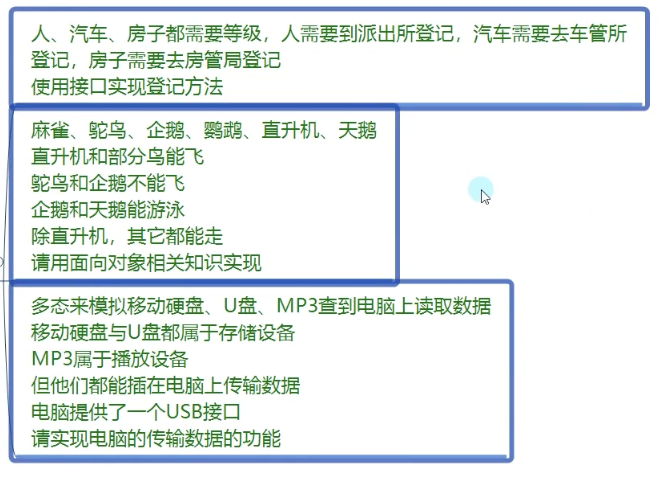
csharp